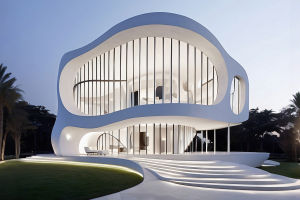Picture a city where your apartment adapts to your needs, grows vertical gardens on the walls, and consumes half the energy of today's buildings.
Urban housing is undergoing a dramatic shift, responding to environmental concerns, population growth, and evolving lifestyles.
But what does the future hold for urban housing design? Let's explore the ideas shaping tomorrow's cities—and your future home.
Why Urban Housing Must Evolve
Cities are growing faster than ever. According to the United Nations, nearly 68% of the world's population is projected to live in urban areas by 2050. This rapid urbanization brings with it a host of challenges: limited land, rising housing costs, environmental pressure, and growing demand for smart infrastructure.
Traditional housing models are increasingly unsustainable—both economically and ecologically. Urban housing must now balance affordability, density, sustainability, and livability. The challenge is clear: how can we design homes that meet the needs of the many without sacrificing quality of life?
Smaller, Smarter Spaces
One of the clearest trends in urban housing design is downsizing—but smarter. Micro-apartments, usually under 400 square feet, are becoming popular in dense cities like Tokyo, New York. These compact homes rely on clever storage, foldable furniture, and modular layouts to make every inch count.
Technology plays a big role too. App-controlled lighting, heating, and appliances help maximize energy efficiency. Movable walls and smart partitions allow residents to change the function of a room in seconds—from a living area to a workspace to a bedroom.
Green Architecture Takes Root
Sustainability is no longer optional—it's essential. Future housing must incorporate green building practices from the ground up. This includes better insulation, solar panels, rainwater collection, and locally sourced materials.
But the green revolution goes even further. Many architects are designing buildings that generate more energy than they consume. Known as net-positive buildings, these structures use renewable energy and advanced materials to reduce environmental impact. Vertical gardens, rooftop farms, and plant-covered facades are also helping bring nature back into concrete jungles.
Flexible and Adaptive Design
The COVID-19 pandemic highlighted the need for flexible living environments. Work-from-home culture, online schooling, and digital healthcare mean that our homes must now support multiple activities. Future housing will likely feature adaptable layouts with rooms that change purpose throughout the day.
Movable walls, convertible furniture, and flexible zoning within buildings allow residents to adapt their space as their needs shift. This kind of dynamic design ensures homes stay functional through life changes like starting a family, remote working, or caring for elderly parents.
Community-Focused Living
Urban housing of the future isn't just about individual units—it's about building stronger communities. Co-living spaces, which combine private bedrooms with shared kitchens, lounges, and workspaces, are already gaining traction. These models offer affordability, social connection, and reduced environmental footprints.
Shared amenities such as rooftop gardens, fitness centers, and communal kitchens foster a sense of belonging and promote sustainable lifestyles. The goal is to create urban neighborhoods that feel less like isolated towers and more like supportive, integrated communities.
Smart Technologies Everywhere
Technology is becoming the backbone of future urban housing. Smart thermostats, lighting systems, and security devices are now standard in many new developments. In the future, entire buildings will be "smart," using sensors and artificial intelligence to manage energy, water, air quality, and even maintenance schedules.
For example, smart elevators will minimize wait times, while buildings equipped with environmental sensors will adjust airflow and lighting to improve comfort and reduce energy use. According to a 2023 report from McKinsey & Company, smart building systems could cut urban energy usa in the next decade.
Dr. Sarah Lindholm, an urban sustainability researcher at the World Green Building Council, stated in a 2022 report that adaptive housing technologies will be critical in meeting environmental targets while maintaining livability.
Prioritizing Well-being
The housing of the future must also support physical and mental well-being. Natural lighting, soundproofing, indoor air quality, and access to green spaces are increasingly important design priorities. Biophilic design—a concept that connects humans to nature through architecture—is becoming a core principle in modern housing.
Features like indoor gardens, large windows, water features, and natural materials such as wood or stone can enhance mental clarity and reduce stress. Architects are now designing with wellness in mind, transforming homes into healthy sanctuaries.
Affordability Through Innovation
Affordability remains one of the greatest barriers to quality urban housing. New approaches are being explored to reduce construction costs while maintaining livability. These include prefabricated modules, 3D printing technology, and recycled construction materials.
For example, 3D-printed houses—once experimental—are increasingly being tested in pilot projects across the globe. These homes are faster to build, cheaper to produce, and often more durable. Prefab housing also enables rapid urban development in areas where traditional construction is slow or costly.
Mixed-Use and Transit-Oriented Design
Tomorrow's urban homes won't exist in isolation. Cities are increasingly turning to mixed-use developments—buildings that combine residential, commercial, and recreational spaces in one. This design approach reduces the need for long commutes and promotes walkable neighborhoods.
Transit-oriented development (TOD) is another trend, where housing is concentrated around public transportation hubs. This model not only reduces traffic and pollution but also makes city living more accessible and affordable for a wider population.
Inclusive Housing for All
Future urban housing must be inclusive—accessible to people of all ages, incomes, and abilities. Universal design principles, such as step-free access, wide doorways, and intuitive layouts, ensure that housing can adapt to people's needs over time.
Government regulations, non-profit involvement, and private-sector innovation all play a role in making inclusive housing a reality. Cities that prioritize diversity in housing design are better prepared to meet the needs of their growing populations.
Global Inspirations, Local Adaptations
While the future of urban housing is driven by global trends, successful solutions are always grounded in local context. Climate, culture, materials, and community values all influence what "good design" means in a given place. Cities must blend global innovation with local wisdom to create homes that feel authentic and sustainable.
In Singapore, for example, high-rise public housing includes shared gardens and schools. In Copenhagen, energy-efficient housing is paired with bike-friendly infrastructure. These examples show that when cities design with both vision and sensitivity, everyone benefits.
Looking Ahead
The future of urban housing is less about building more and more about creating smarter, greener, and human-centered spaces. As cities expand, the choices we make now will shape how people live for generations.
What kind of home would you want in the city of tomorrow? One that saves energy, adapts to your life, connects you with neighbors—or maybe all of the above? The future is already being drawn—brick by digital brick.
We'd love to hear your thoughts: What features do you think should be essential in future urban homes?


